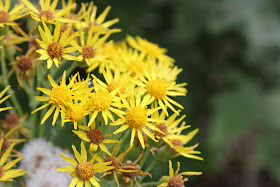 |
| Maple beetles are thriving in the burn area |
Insect life has returned to the burn zone too, mostly in the form of numerous maple beetles crawling on the trail and on most of the aforementioned plants and flowers. Ladybugs were also spotted huddling together for shelter on the underside of common yarrow flower heads.
 |
| Lower Fall Creek Falls |
Because of the lack of foliage, we could actually now observe both upper and lower falls at the same time from a fair distance away. Even though the picturesque cascade was fully visible, it still was much cooler to admire the lower falls from the splash basin and the upper falls from a railed overlook, and we obliged both.
 |
| It was a berry nice hike |
The hike to the falls is pretty short, which is one reason I haven't hiked there all that much. So, for some extra mileage we explored the forest road at the top of the cascade. The homes that had been here before had also been lost to the fire and the road was clearly sagging, ready to slide downhill at the slightest provocation, like hikers walking on it. The atmosphere up here among all the death and destruction was somewhat on the forlorn side, although the blackberries growing here were delicious.
 |
| The "forest" at Susan Creek |
Susan Creek was likewise ravaged by Archie but it was conveniently located on the way home, so we stopped there for another short hike to another spectacular waterfall. Just like at Fall Creek, the hike took place among the charred skeletons of trees past. But at least there was no coroner's pictograph on the parking lot pavement.
 |
| Pretty to look at but common tansy is not welcome |
There were the same type of wildflowers seen at Fall Creek but there were some different ones too. The yellow daisy-like flowers of common tansy were pretty to look at but are most unwelcome, since tansy is a prolific invasive species. Pale blue wild chicory and lavender-tinted aster were more abundant here than they had been at Fall Creek.
 |
| Susan Creek Falls |
Susan Creek Falls tumbles over its rocky ledge in spectacular fashion, although it's still a bit odd for us old-timers to see the falls in bright daylight instead of in its former mossy and shady basin. Get used to it Richard, it's not going to change much during your remaining time on this planet. We lunched at the picnic area below the falls and enjoyed the scene as we ate our respective fruits, snacks, hot peppers, and gummy worms.
 |
| Stink bug gendarmes escort the St. John's wort beetle prisoner |
As at Fall Creek, insect life abounded on the surrounding vegetation. Shiny black St. John's wort beetles thrived not on St. John's wort, but on fireweed instead. Stink bugs wandered among the St. John's wort beetles, trundling along like insectile armored tanks warring over the same patch of fireweed. Not willing to engage hostile bug forces in combat over fireweed apparently, maple beetles crawled all over thistle plants and not on maples as their name would suggest.
 |
| Western tailed blue butterfly |
Not all of the insects were of the beetle variety as numerous butterflies danced from flower to flower. Of note were some brilliant sulfur-colored butterflies that would not stay still long enough for stealthy photographers. Oh well, I had to settle for a photo of a gray butterfly thingy but the fun was all in the chase.
 |
| One small piece of Fall Creek Falls |
All of us on this outing are long-time (also known as "old") hikers and are quite familiar with how things used to be along this section of the North Umpqua River. To keep sane, which is a relative term, one just needs to accept the basic fact that things will never be like they were, at least during our lifetime. However, it's not necessarily a bad thing and these two short hikes proved the point that there is still great beauty along the river post-fire, it's just a different kind of beauty than what used to be.


























No comments:
Post a Comment